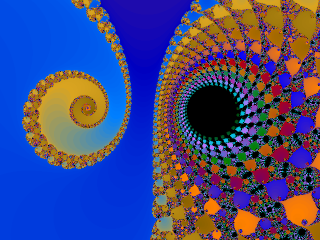By Naomi Dolin-Aubertin
This week something a little different. Each week, I spend some time on the internet looking for articles about internet technology, tech advances and cloud computing to post on our Facebook and social media. Recently, I ran across this wonderful video about Benoît B. Mandelbrot, the scientist who discovered fractals.
Fractals, you might remember from school, are the mathematically infinite shapes that give everything in our universe its form. "Their irregular, repeating shapes are found in cloud formations and tree limbs, in stalks of broccoli and craggy mountain ranges, even in the rhythm of the human heart." [1] When I say that fractals are mathematically infinite, I mean to say that you can zoom in and in forever and the fractal will repeat the same shape into infinity. "So the fractal lacks scale. A small portion of the fractal is just as detailed as the original." [2] For the longest time, we were unable to make sense of the patterns we saw in nature because we lacked the tools to do so. Those tools: computers.
 |
| Fractals in nature: romanesco broccoli |
So why do we need computers to calculate what are essentially very simple mathematical equations? Consider, on the surface, a cloud or a mountain looks extremely complex. Mandelbrot said, "Think not of what you see, but what it took to produce what you see." [3] This is closely linked to the idea of chaos theory. Bear with me here. "The natural world has always had a chaotic way about it." "Many systems which scientists have considered totally random, unpredictable and without form have now been found to be otherwise. There is form and pattern hidden within the chaos." [4] The math for finding these patterns is actually surprisingly simple, but it requires millions of computations to work them out.
 What does this have to do with technology you might ask? Well, if fractals are the patterns underlying our universe, then by extension, the world we build around us - art, design, computer code - naturally mimics these patterns. This brings us to the idea of the fractal web. The internet is very similar to the infinite geometric repetition of fractals. This takes two forms: internet traffic and the content hosted on it.
What does this have to do with technology you might ask? Well, if fractals are the patterns underlying our universe, then by extension, the world we build around us - art, design, computer code - naturally mimics these patterns. This brings us to the idea of the fractal web. The internet is very similar to the infinite geometric repetition of fractals. This takes two forms: internet traffic and the content hosted on it.
Let's look at the traffic first. Isn't it beautiful? This mesmerizing image grew out of a bet that one man could not map the entire Internet in one day. One of the benefits of cloud solutions we talk about are their scalability. This is due to the fact that, like fractals, the internet is independent of scale. Or "the structure of the Web is interestingly different because of the lack of two-dimensional constraint." [5] The internet can stretch on and on, flying outwards like our universe into an unbounded space. To illustrate how this looks on a fractal-like level, examine the fact that large quantities of data and tiny emails travel in much the same way, carried along in data packets that look much the same whether they are on a large scale or small. [6] A large data stream is composed of many data packets, which is composed of smaller data packets; you get my drift.
Likewise when we look at the content on the internet.
 |
| Fractal fascination. |
Looking at a Web page, you can't tell from its structure whether it's part of a huge website or one with just a few pages...Whether you look at a home page showing sections of a site with thousands of pages, or have drilled down through many layers to a page giving information on one particular object, the Web page structure remains the same, with a head, a body and HTML coding. As with fractals, the structure repeats itself. [7] The internet is composed of trillions upon trillions of bits of data that spread outwards into infinity. It is a vast, interconnected web that relies upon the same basic structures, the code, in order to exist. It is with search engines - those vast computational machines - that we are finally able to navigate this great web of data because they can run the millions of calculations necessary to create order out of the seeming chaos.
Quite ironically, you can use these patterns (code) to create more patterns (fractals) with internet-based fractal generator. Order out of chaos out of order.


Leave a comment!